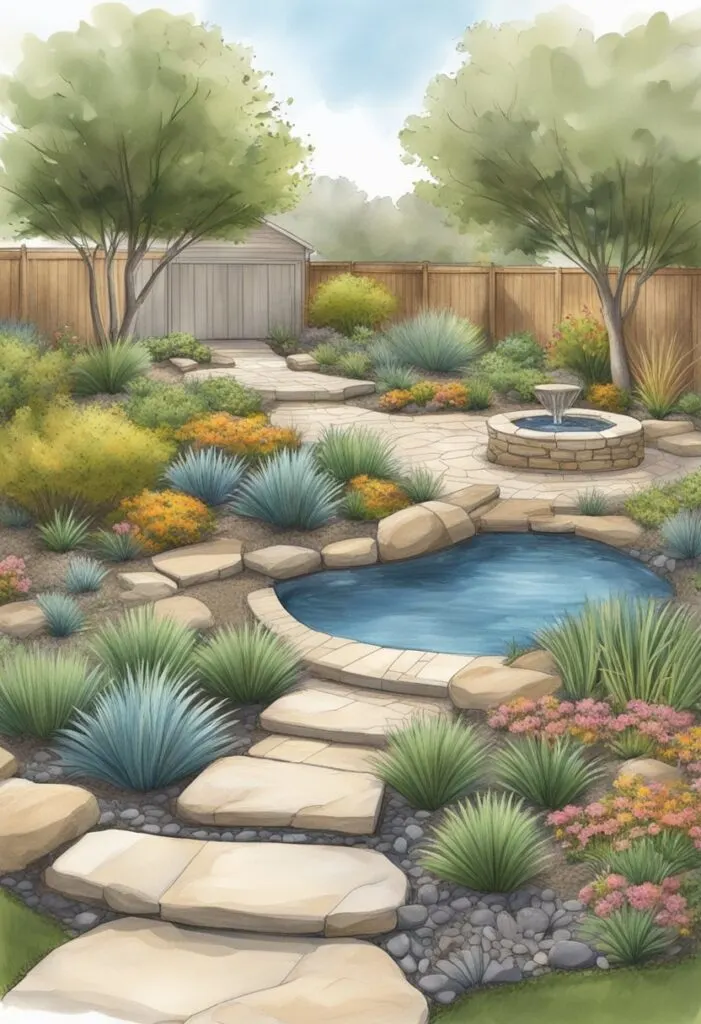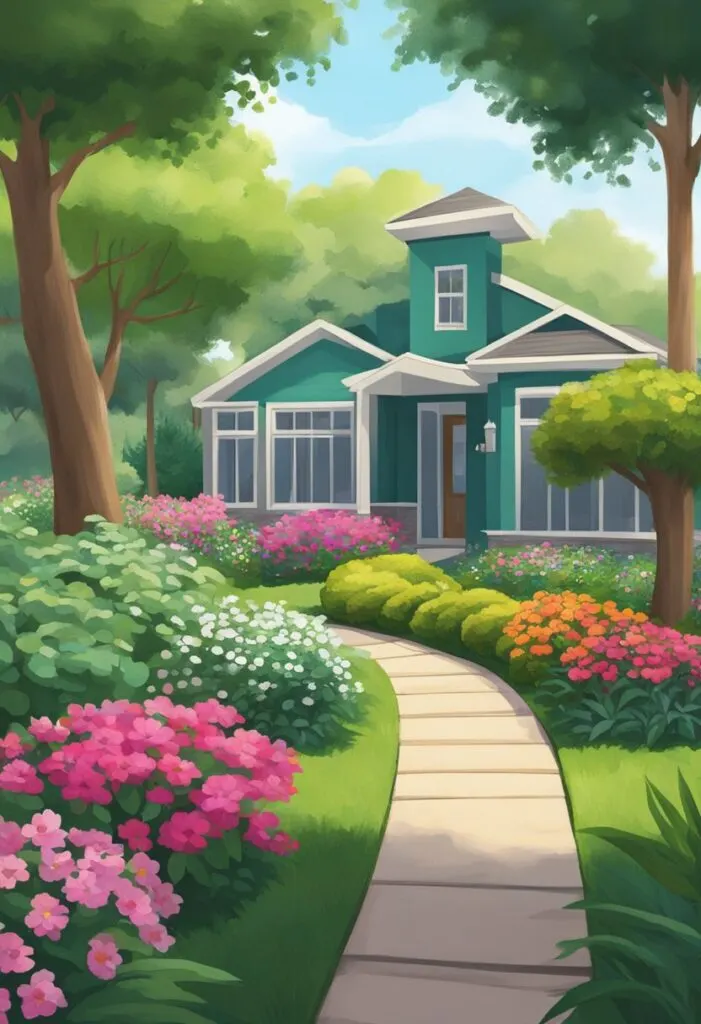While I usually stick to writing about parenting, faith, and health, sometimes mommas just need ideas about how to make their homes (including their backyards!) more functional and family friendly.
We’ve chatted a bit about backyard organization, cheap backyard pool ideas, and solutions for a muddy backyard but can we just address the elephant in the room? Texas (where I live) backyards are not like most other backyards.
From extreme heat, to long dry seasons, to the fact that half of our backyards are just a few inches of soil spread over rock, Texas backyards pose a very distinct challenge to homeowners attempting to make the most of their outdoor space. So I felt it was only appropriate to share some backyard landscaping ideas in Texas, specifically.

Assessing Regional Landscaping Needs
When landscaping in Texas, understanding your specific regional needs is crucial. Texas’ diverse climates, from arid West Texas to humid South Texas, present unique challenges and opportunities for your garden.
Understanding Local Climate
North Texas tends to have a continental climate, with cold winters and hot summers. This means your landscaping choices must thrive in varying temperatures.
Meanwhile, West Texas is known for its arid conditions, so plants here need to withstand drought and heat.
In contrast, South Texas enjoys a more humid environment, requiring plant selections that can handle moisture and mild winter conditions.
Choosing the Right Plants
For North Texas, consider hardy options like autumn sage or live oaks that can endure temperature swings. In the drier regions of West Texas, opt for drought-resistant plants like Texas sage or ocotillo.
For your South Texas yard, plants such as esperanza or oleander are better suited to the humid climate.
Water Conservation Strategies
Regardless of where you live in Texas, conserving water is a priority.
Utilize xeriscaping techniques for the dry regions of West Texas, which focus on low-water-use plants. In North and South Texas, incorporating rain gardens or using drip irrigation systems can help make the most of every drop.
Lastly, of all the backyard landscaping ideas in Texas, remember that mulching is especially essential. It conserves water, regulates soil temperature, and helps prevent weeds.

Designing Your Texas Garden
When you’re ready to add charm and a personal touch to your landscape, focusing on elements that thrive in the Texas climate will ensure your garden not only survives but flourishes. Let’s dive into specific ways to create a space that’s both beautiful and functional.
Incorporating Native Plants
Native plants are not just an environmentally sound choice for your Texas garden, but they also provide a trouble-free way to have a dynamic and resilient landscape.
Start by designating garden beds or plant beds around your front door and walkways to elevate your curb appeal. Selecting natives like Texas bluebonnet or purple sage can offer year-round colors and become a natural focal point.
- Advantages of Native Plants:
- Low Maintenance: Once established, they require much less water and care.
- Pest Resistance: They are naturally adapted to Texas pests.
- Attracts Wildlife: They are a magnet for local birds and pollinators.
Creating a Rock Garden
Rock gardens can add texture and depth to your landscaping design, especially in areas where water conservation is critical.
Use a variety of stones to construct pathways or define garden sections. Combine different sizes and colors to complement succulents and drought-tolerant plants, creating an attractive scene that requires minimal upkeep.
- Tips for Rock Gardens:
- Use bold rocks as the anchors to your design.
- Opt for native succulents that thrive in the Texas heat.
Installing Water Features
Water features can transform your backyard into a tranquil oasis.
Consider installing a small fountain or a bird bath, which can serve as a gathering spot for local wildlife. Placing these near seating areas allows you to enjoy the soothing sounds, creating a serene escape in your own backyard.
Just remember to keep features proportional to the size of your garden to maintain balance.
- Water Feature Ideas:
- Birdbaths
- Fountains
- Small ponds
Building an Outdoor Kitchen
For those who love entertaining, an outdoor kitchen extends your living space and brings functionality to your garden. It can serve as the ultimate focal point for gatherings.
Plan your outdoor kitchen close to your home for convenience and incorporate materials that match your house and garden for a cohesive look. Include plenty of countertop space and consider adding a pergola for shade.
- Outdoor Kitchen Essentials:
- Grill or cooktop
- Prep and serving counters
- Shaded seating area
Enhancement Features and Accents
Incorporating focal points like rocks and boulders, establishing a cozy fire pit area, or utilizing groundcovers and mulches can instantly elevate your Texas backyard into an attractive and functional outdoor space.
Adding Decorative Rocks and Boulders
Integrating decorative rocks and large boulders into your landscaping creates a natural, yet structured look.
River rock gardens are a great idea for low-water areas, providing both aesthetic appeal and practical benefits such as erosion control. Meanwhile, strategically placed boulders can serve as natural seating or markers for different areas of your garden.
- Rock Garden: Choose an area where these features will stand out, yet complement your overall landscape design.
- Installation Tips: To avoid injury or damage, consider professional help when placing large boulders.
Setting Up a Fire Pit Area
A fire pit is the best option for adding warmth and a social gathering spot in your backyard. Whether it’s a permanent installation or a portable unit, a fire pit area can be a focal point where you enjoy cool Texas evenings.
- Fire Pit Tips:
- Ensure it’s placed at a safe distance from your home and plants.
- Surround the feature with gravel or wood chips to prevent the spread of ashes.
Using Groundcovers and Mulches
Groundcovers and mulches are good ideas to enhance the soil quality and add color contrast to your backyard. Colorful flowers can peek through the mulch, creating a vibrant layer of texture and color.
- Best Practices: Select native groundcovers that thrive in Texas’s climate and combine them with organic mulches like wood chips for sustainability and soil health.
Backyard Landscaping Ideas in Texas: Plant Selection and Care
When landscaping your Texas backyard, choosing the right plants and knowing how to care for them is crucial. You’ll want to focus on native plants that are drought-tolerant and consider options for both lush flower beds and stately formal gardens, as well as embracing low-maintenance alternatives to fit your lifestyle.
Caring for Flower Beds
To keep your flower beds vibrant and healthy, incorporate a variety of Texas native flowers that will thrive in the local climate. Choosing new flowers like the Texas Bluebonnet or Hinckley columbine can add a pop of color to your garden.
Regularly deadhead spent blooms to encourage new growth and ensure your soil retains moisture by using an organic mulch layer.
- Watering: Early morning is the optimal time to water your flower beds, reducing evaporation and giving plants sufficient moisture to last through the heat of the day.
- Mulching: Apply a 2-3 inch layer of mulch to conserve water, suppress weeds, and maintain soil temperature.
Growing a Formal Garden
A formal garden with geometric shapes and symmetrical patterns can be a stunning addition.
Choose ornamental grasses or southern sugar maple for structure and height. Plant in symmetrical patterns or in pairs for a balanced look.
Make sure to establish a regular pruning schedule to keep hedges and shrubs in proper form.
Embracing Low-Maintenance Options
Low-maintenance doesn’t have to mean dull.
Opt for drought-tolerant plants and native Texan species that require minimal watering and care. Consider using hardy plants and stonescapes for areas where less upkeep is desired.
- Xeriscaping: This landscaping method reduces or eliminates the need for supplemental water from irrigation and is perfect for Texas climates.
- Native Plants: Examples include Texas Purple Sage and Turk’s Cap, which are both attractive and low-maintenance.
Landscaping for Wildlife and Ecosystem Health
Transforming your backyard into a haven for local wildlife not only brings a slice of Texan nature to your doorstep but also plays a vital role in preserving ecosystem health. Here’s how you can create a thriving outdoor space that supports local fauna and flora.
Creating Habitats for Local Fauna
To welcome local wildlife, consider installing a rain garden. This is an excellent way to manage rainwater runoff and provide a natural water source for animals.
Rain gardens work as self-sustaining ecosystems, attracting insects, birds, and amphibians. Pair this with containers gardens, which can offer both food sources and shelter, and you’re setting up a sanctuary right in your yard.
Choosing Wildlife-Friendly Plants
When selecting plants, prioritize native species that local wildlife thrives on. These plants require less water and care, making them a great way to support the environment while also reducing maintenance.
Use a mix of flowers, shrubs, and ground cover to offer a diverse habitat. Not only will these plants attract pollinators, but they’ll also provide food and nesting materials, helping your backyard ecosystem to flourish.

Backyard Landscaping Ideas in Texas: Irrigation and Maintenance Strategies
In the Texas heat, your backyard’s survival hinges on smart irrigation and savvy maintenance. It’s about conserving resources while giving your landscape exactly what it needs.
Utilizing Drip Irrigation Systems
Drip irrigation is a game-changer for your garden. It delivers water directly to plant roots, causing less evaporation and runoff than standard sprinkler systems.
By installing automatic irrigation systems, you ensure that your plants get the little water they need, precisely when they need it. This not only saves water but also keeps your water bills lower.
- Benefits of Drip Irrigation:
- Low maintenance: Set it up and let the system do the work.
- Less water usage: Drip systems reduce water waste, important in drought-prone areas.
- Tailored watering: Adjust the flow to meet specific plant needs.
Implementing Mulching Techniques
Mulching is both an art and a science. Applying a layer of mulch around your plants helps retain moisture. This means you’ll need less water to keep your backyard thriving.
Less maintenance is required as mulch also suppresses weeds and adds nutrients to the soil as it decomposes.
- How to Mulch Effectively:
- Choose an organic mulch to improve soil health.
- Apply a 2-3 inch layer. Avoid piling it against plant stems to prevent rot.
Focus on these strategies to make your Texas garden require less work and use fewer resources. This will lead to a lush outdoor space that’s easier on the environment and your wallet.

Now that you have some backyard landscaping ideas in Texas under your belt, which will you try first?! From my backyard to yours, happy landscaping!

P.S. Want to couple your time outdoors with a healthier lifestyle? Sign up for instant access to our handy dandy calendar, 28 Daily Goals to Kickstart a Healthier Life. It’s the perfect tool to introduce you to some super simple ways to improve your health, and to help you transition into a healthier mindset in just 28 days. Best of all, it’s completely free! Get yours HERE.
Disclosure: While all opinions are our own, we are a participant in the Amazon Services LLC Associates Program and other affiliate advertising programs, designed to provide a means for us to earn fees by linking to Amazon.com and affiliated sites, at no additional cost to you.



